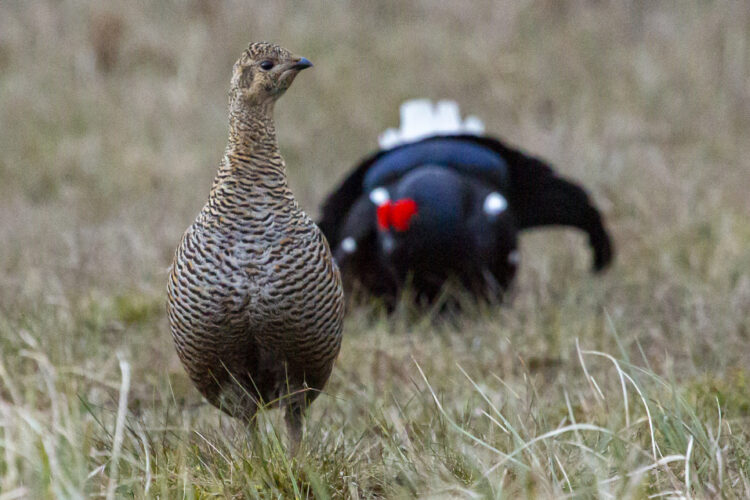Black grouse engage in a spectacular and noisy breeding courtship in spring which is both bizarre and entertaining to see. Martin Rogers, who has witnessed the ‘lek’ several times, describes the experience…
Upper Teesdale, as residents know and visitors soon learn, is a very special place for nature. According to the North Pennines National Landscape (NPNL), 36 per cent of the area is designated as Sites of Special Scientific Interest. It contains 40 per cent of the UK’s upland hay meadows; it is one of the UK’s top five botanical hotspots, with a unique collection of rare plants (the ‘Teesdale Assemblage’); it is the English uplands hotspot for breeding wading birds; and it is home to 80 per cent of England’s Black Grouse.
Black grouse is one of our most charismatic species, especially during the breeding season, when the males gather at traditional sites (known as ‘leks’) to compete for the attention of females by performing a bizarre and spectacular display.
With binoculars and/or a telescope, it’s possible to witness this from your car at several locations in the dale – but stay in the car or the birds will fly off! The NPNL website has more information about black grouse, and a watching code – they are seriously endangered and must not be disturbed.
There is also information about black grouse on the websites of the British Trust for Ornithology, the RSPB and the Game and Wildlife Conservation Trust. Sadly, all of these describe the dramatic decline in their population and extent over the course of the 20th century, particularly marked in its last decade.
Now a ‘Red List’ species of conservation concern, black grouse have been the subject of a variety of statutory and other conservation initiatives. This included a North Pennines Recovery Project between 1996 and 2010, which led to a significant increase in numbers, which have apparently remained stable since then.
I have been lucky enough to observe the lek on a number of occasions, both from my car and from a hide – for which a permit is required from the landowner.
This involves being in place by 4am, well before sunrise, to avoid disturbing the birds. The visual display is accompanied by an equally extraordinary vocal performance, the sound of which carries a surprising distance – and defies description in words.
You can get a very good idea what it’s like from my video, which includes a large number of hen birds which, unusually, are also displaying, (youtube.com/@martinrogers8226).
And, as you will hear in places, lapwings, curlews and snipe add to the joyful chorus of moorland birdsong.
On a good day, the sun will shine (once it’s risen over the hill), which gives man and birds a lift. The most glum I’ve seen them was when it had snowed overnight – and I was pretty glum too (and cold).
The biggest local lek (usually with around 20 cock birds, but fewer hens) is visible from the road between Langdon Beck and St John’s Chapel. And when you have seen and heard enough, or when the birds have displayed enough and gone off elsewhere to feed – which they tend to do rather suddenly by around 9am – then you can go and get some breakfast at the nearby Langdon Beck Hotel or the slightly further High Force Hotel (booking advised in both cases).
l Martin Rogers is a local photographer and author (of Essential Teesdale and a booklet, High Force). He is also a trustee of the Teesdale Special Flora Trust and an Associate Artist of the new Kirkcarrion Gallery in Middleton.






